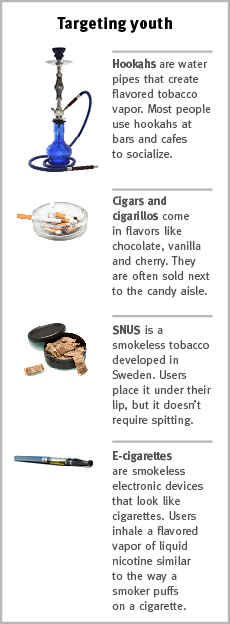Beating Them at Their Own Game
By Martha McKenzie, Illustrations by Sarah Jane Coleman

Carla Berg is trying to think like a tobacco executive. The associate professor in behavioral sciences and health education wants to borrow the sophisticated market segmentation techniques the tobacco industry has used so successfully for decades to lure smokers. Berg, however, plans to use them to identify young tobacco users and convince them to quit.
"Public health professionals are not as good at marketing our product, which is health, as the tobacco industry is at marketing its products," says Berg, who is currently working toward her MBA in marketing at Emory's Goizueta Business School. "This is particularly true when we try to target youth, who believe they are going to live forever."
But immortality and tobacco usage don't mix. While smoking rates have declined in the 50 years since the Surgeon General's report on the hazards of tobacco use was released, smoking remains the leading cause of preventable death in the United States. And it's not just about cigarettes anymore. A host of new products that appeal particularly to youth have arrived on the scene. Hookahs and water pipes can be enjoyed in trendy, social hookah bars. Smokeless tobacco products, such as Snus and other dissolvable strips and lozenges, don't require spitting, making them more appealing to image-conscious users. Some cigarette-sized cigars contain enticing flavorings, such as grape or strawberry. The newest arrival, e-cigarettes, come in a dizzying variety of devices, each with a plethora of flavored liquids from which to choose.
"Young people who are starting to dabble in these alternative products, or even in cigarettes, generally don't even identify themselves as smokers," says Berg. "They tend to think hookahs, smokeless products, and the like are not particularly harmful. These kids and young adults are on a slippery slope, and if we could intervene in time, we might be able to stop them before they become addicted to nicotine."
To achieve this, Berg is taking a page from the tobacco industry's book on marketing—literally. In the 1990s, many private tobacco industry documents were released to the public as a part of the Master Settlement, in which the largest U.S. tobacco companies agreed to change the way tobacco products are marketed and to pay states more than $200 billion. The consumer segmentation and marketing that tobacco companies used to lure consumers, particularly youth and young adults, were revealed.

"In public health, we segment by demographics—gender, age, race, ethnicity. That's about as sophisticated as we get," says Berg. "The industry documents showed that tobacco companies segment along the lines of lifestyle characteristics—attitudes, values, who people hang out with, what kind of music and fashion people enjoy. These kinds of things get at who people really are and how they behave, which has allowed tobacco companies to create marketing and advertising that specific sets of consumers can identify with."
Berg recently published a study that looked at whether the same tactics could be used to identify specific groups at elevated risk for tobacco use and, ultimately, to fashion anti-tobacco messages that would resonate with each segment.
Students from six colleges and universities in the Southeast filled out questionnaires that used psychographic measures adapted from tobacco industry documents. They were asked to rank their personality characteristics, such as extraversion, emotional stability, and agreeableness, as well as the characteristics of their friends, such as 'My friends drink,' or 'My friends get good grades.' In addition, participants noted their feelings about future career and family success and their religious services attendance.
|
|
Ultimately, respondents were segmented into three groups—safe responsibles, stoic individualists, and thrill-seeking socializers.
Among each group, Berg measured the use of cigarettes, hookahs, Snus, cigarillos, and other tobacco products. She did not include e-cigarettes since they were too new when she initiated the study.
As might be expected, the safe responsibles, characterized by high levels of agreeableness, conscientiousness, emotional stability, high academic achievement, and regular attendance at religious services, reported the lowest levels of tobacco use. Fifteen percent used cigarettes, under 3% used hookahs, and hardly any used smokeless tobacco or Snus.
Thrill-seeking socializers, characterized by high levels of sensation seeking and extraversion, had the highest tobacco use. More than a quarter used cigarettes and almost 6% used hookahs.
Stoic individualists, characterized by low ratings of extraversion, sensation seeking, and openness and a pessimistic outlook of future occupational and family success, saw different use patterns between the sexes, with women having lower tobacco use rates than men.
"We can take this information and tailor public health messages to each specific segment," says Berg.
For example, while safe responsibles are generally at low risk for tobacco use, they might be receptive to messages warning of the dangers associated even with very low levels of tobacco use and the risk of progressing to higher levels of use.
Messages targeting thrill-seeking socializers could emphasize the unattractive aspects of heavy tobacco use to counter the tobacco industry's image of smoking as fun and attractive.
Campaigns speaking to stoic individualists could target the sexes differently. For men, public health campaigns could emphasize other ways to cope with pessimism, such as exercising. For women, messages could suggest talking with family and friends to overcome low self-esteem.
"I would like to see us infuse our work with the same sophisticated marketing strategies used by the tobacco companies," says Berg. "We can take lessons from them to beat them at their own game."
Related Resources:
"Changing smokers' habits to protect children at home" (1/5/2015)
"Love, not nags, may best help a smoker quit, Winship Cancer Institute expert says" (2/21/2012)

